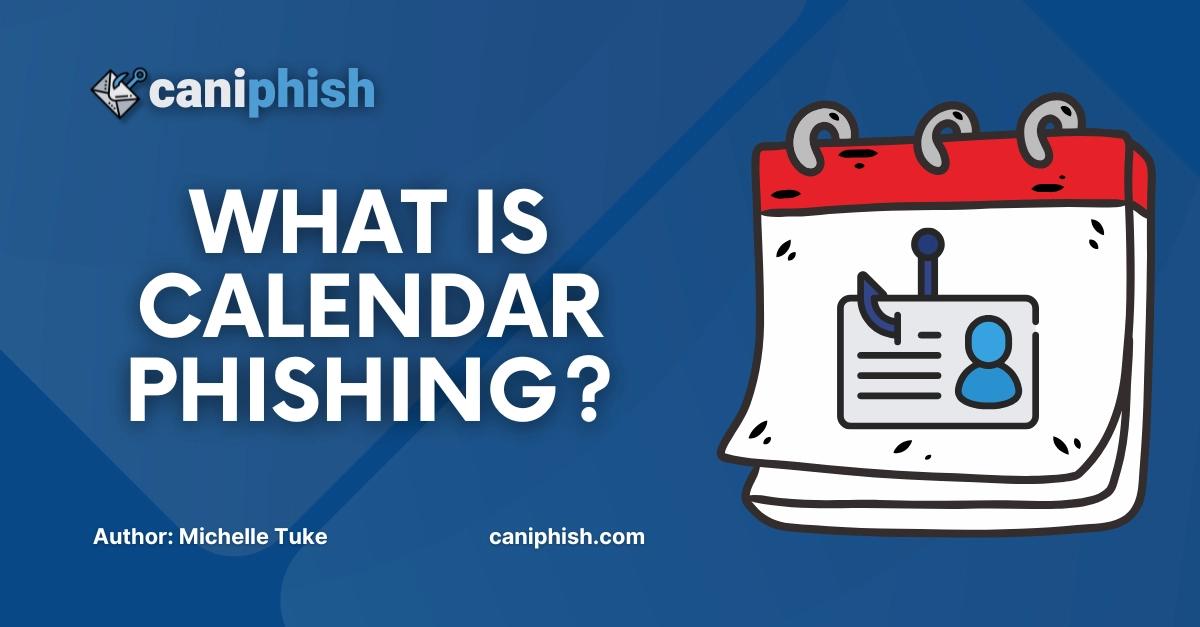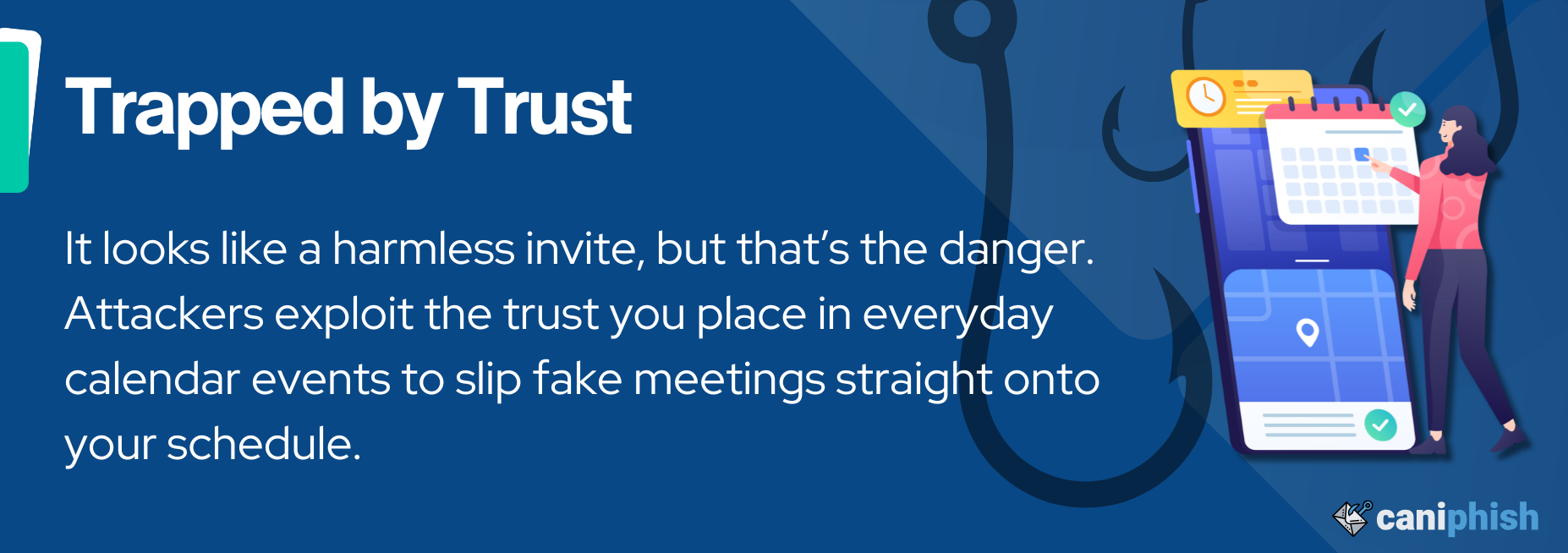What Is Calendar Phishing?

Calendar phishing is a social engineering tactic in which cybercriminals trick someone by delivering fake calendar invites that often contain malicious links or attachments designed to steal data or install malware.
What Makes Calendar Phishing So Dangerous?
Calendar phishing is dangerous because you don't expect something as ordinary as a calendar event to be a phishing attempt. It hides in plain sight, often behind the names of trusted tech platforms used by millions of people, so it is often overlooked as a threat. Attackers take advantage of that built-in trust, especially with features like "automatically add invitation," which can sneak events into your calendar without any clicks at all.

How Does Calendar Phishing Work?
Attackers use calendar invites as a stealthy way to deliver malicious links right into your daily schedule. Here's how it typically plays out:
-
Profiling
Using social media, LinkedIn, and public sources like recent press releases, cybercriminals gather details about a targets habits, role, and schedule.
-
Crafting The Lure
Armed with the research collected, the attacker can design a personalised invitation with a convincing title, sender name, and malicious attachment or link.
-
Delivery
The fake invitation is sent via the calendar system or occasionally by email. Some email clients have an auto-add feature, which doesn’t require user action. If this is enabled on the victim's email client, it can increase the effectiveness of the calendar phish.
-
Notification
The victim gets an alert that there's a new calendar event, which can be a pop-up, email summary, lock screen notification, or mobile push.
-
Execution
In some cases, just receiving the event is enough to get into your calendar. The real damage often happens when the user attempts to join the meeting and clicks a malicious link or downloads an infected attachment which triggers the attack.
-
Exploit and Escalation
The attacker uses the stolen credentials, deploys malware, or leverages email account access to move through the network, gain higher access, and steal data.
What Could Happen If You Click A Malicious Calendar Link?
Like any other social engineering scam, the consequences can snowball quickly if you click on a malicious calendar link. Here's what could happen;
- Credential Theft: Clicking a deceptive link could take you to a fake website designed to steal your credentials.
- Malware Infection: Calendar invites can contain harmful downloads that exploit user systems leading to infections like keyloggers, spyware or ransomware.
- Further Scams: Once infected, the attacker can access your account and contact list. Your identity is then used to launch further attacks.
- Account Takeovers: Without two-factor authentication, attackers can hijack your account and gain access to sensitive documents, messages and meeting links.
- Business Disruption: Calendar phishing can lead to invoice fraud and unauthorized access to the internal system, compromising the whole organization.
Who Is Most At Risk Of Calendar Phishing?
Anyone using a collaboration platform such as Gmail or Hotmail is at risk of calendar phishing, but professionals are especially at risk. People in business environments often rely on calendar invites to schedule meetings, engage with external partners, and manage appointments, making it harder to tell the difference between a legitimate invitation and a fabricated one.
How Can I Tell If It's Calendar Phishing?
One of the biggest red flags is the use of urgent language, such as "Immediate Action Required." This can cause pressure, resulting in users clicking the malicious attachment, link, or calendar event without thinking.
Watch for events that stir curiosity, like "Confidential HR Review." Calendar phishing often relies on psychological manipulation to trick users.
Awkward wording, poor grammar, and sloppy formatting of the event titles or descriptions are a cause for concern. If your calendar suddenly floods with back-to-back or repeated events, it's a strong indicator that you are a target of calendar phishing.
How Do I Prevent Calendar Phishing?
Calendar phishing is just another flavor of social engineering, so the same golden rules apply to any other phishing scam. Here are some steps you can take to better protect yourself from calendar phishing;
Keep Everything Updated
Keeping your operating system, browser and security tools updated is the simplest way to stay one step ahead of cybercrime. Software vendors patch vulnerabilities that attackers exploit, so regularly updating everything can close the gap between you and the threat.
Inspect Sender
Look at the entire email address and domain, not just the name. Attackers often spoof trusted contacts or use subtle misspellings to trick you. In most cases, you'll need to click or expand the sender's details to see the full address, especially if you're using a mobile app.
Don't Trust Random Invites
Always be skeptical of unfamiliar people or organizations. Be sure to verify directly with a sender through a safe channel before accepting an event or clicking a link.
Disable Auto-Adding Events
Some calendar platforms automatically accept incoming invitations or events, even without your interaction. If your platform allows it, be sure to disable this feature.
Treat Calendar Invites Like Emails
If you wouldn't click on a suspicious email, you shouldn't click on a sketchy calendar event either. Just because something shows up in your calendar doesn't make it trustworthy. Treat both with the same level of caution.
Limit Calendar Access
Only share your calendar with trusted individuals. If your schedule is open to anyone, it’s easier for attackers to study your habits and craft realistic phishing invites that match your day-to-day schedule.
Review Connected Apps
Double-check which services and apps currently have access to your calendar account. Disable access to anything you no longer use or don't recognize. This includes third-party plugins or scheduling tools.
Use Two-Factor Authentication
By protecting your calendar and email accounts with two factor vertification, you're stopping the attacker in their tracks. Even if they get your credentials, they can't proceed much further without that second layer of security.
Step Into The Mind Of A Hacker
The Social Engineer is a high-stakes, turn-based cyber game where you play as an up-and-coming criminal mastermind.
Play now!Frequently Asked Questions
What Are The Most Common Calendar Platforms Affected By Calendar Phishing?
Calendar phishing targets any major calendar platform that supports events, invites, and integrations. The most commonly exploited are the following;
- Google Calendar - This is the most targeted due to its popularity and the auto-add features.
- Microsoft Outlook/Office 365 - Popular in the organizational circles where attackers often use fake Outlook or Teams invites to lure victims.
- Apple Calendar (iCloud) - Attackers have used calendar subscriptions and spam invites, which are less common but still effective.
- Yahoo Calendar - Not as dominant as the others, but used by individuals and small businesses.
- Third-Party scheduling Tools – These are apps like Zoom, Meetingbird, or Calendly which can be impersonated or abused to send out deceptive meeting invites.
Why Don't Email Filters Catch Calendar Phishing?
Email filters don't always catch calendar phishing because many malicious invites don't arrive via email, allowing them to bypass traditional spam protection. Having the add-event automatically feature means these events often don't even touch your inbox, so traditional email filters don't get a chance to block or scan them. When a fabricated event does manage to land in your inbox, they're often carefully crafted to appear legitimate, avoiding detection by keyword-based filtering systems.
Is Calendar Phishing A Form Of Business Email Compromise (BEC)?
Yes, it can. If an attacker impersonates a trusted figure, like an executive or HR representative, and uses that identity to send malicious calendar invites, it falls under the BEC umbrella. The delivery method may differ, but the goal is the same.
How Can Attackers Exploit Zoom Or Teams Calendar Invites?
Attackers take advantage of how easily calendar apps sync with Zoom and Microsoft Teams by sending fake invites that look legit. When users click "Join Meeting," they are redirected to a spoofed login page designed to steal their credentials or trigger a malware download.
Do Malicious Invites Sync Across All Devices?
Yes. Once added, fake calendar events sync like any other, meaning malicious links or attachments follow you across your phone, tablet, desktop, and even your smartwatch!
